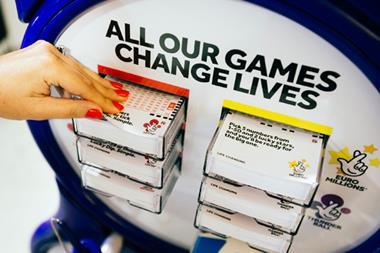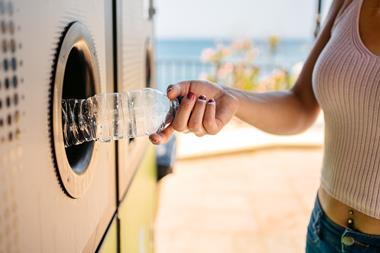analysis by Peter Robinson
You would think that with the proliferation of sophisticated portable electric devices, from CD players to toys, battery sales would be rocketing.
But sales have increased just 4% in volume with competitive pressures driving a fall in value of 6% [TNS Impulse, year to July 23 2000].
Batteries are more efficient, reliable and offer increasingly longer life. And the perverse reward the industry gets is that consumers buy fewer of them!
As one manufacturer says: "Batteries are just not sexy products and, more often than not, are grudge purchases." Batteries are also becoming smaller, lighter, and deliver more power.
Batteries have always represented a good business proposition for retailers since it's a sector where the margin can be several times higher than the wholesale price. There have been claims this has contributed to making batteries unduly expensive in the UK, while the multiples in turn have blamed prices on UK suppliers and some have sourced on the grey market outside the UK.
Not surprisingly, the multiples have been at the forefront of price cutting to the benefit of consumers. Varta's trade marketing manager Paul Fildes says: "It was inevitable the top grocery multiples would select high margin categories like film and batteries to make deep price cuts.
"Now that the dust has settled, the lowering of retail prices has resulted in £23.4m worth of retail revenue being lost from this mature market and leading brands in particular have seen their prices slashed by up to 50% from their normal levels of just one year ago. This represents significantly better value for the average consumer of batteries."
There has been a battle of the brands with the grocery chains increasingly willing to discount. Gillette business unit director for batteries Stephen Tennant, who looks after Duracell, the number one brand in the market, says: "Over the last 12 months we have seen a changing scene particularly in the grocery area with a lot of different pricing positions taken by retailers, driving differential between volume and value."
Every household in the UK has around 20 appliances needing batteries. The list is growing. An average of one in eight people are in the market for batteries in any average four week period, buying 6.8 batteries [Varta].
Long life appears to be firmly at the top of the consumer agenda. Philips marketing manager Glenys Henry says: "Length of life is regarded as significantly the most important attribute. This is followed by price, followed by the brand which is also closely related to the first attribute, length of life."
Almost two in three decisions to buy are spontaneous. Batteries are a planned but often forgotten purchase.
Grocery is still the largest sector of the total UK battery market. In volume the multiples have 32.1% and impulse outlets the rest. But the multiples' volume share is growing faster, up 7.5% in the year to July 23, with the impulse share up 2.9%, while value was down for both, at 4% and 7.1% respectively.
The battery market is worth almost £254m with alkaline and zinc accounting for 92% of sales. The lower power, zinc batteries continue to decline, down 2%, with alkaline up 6%, and both fell in price. Most of the development work and longer life products have been in the alkaline area, though Panasonic, dominant in zinc, has produced a high efficiency anode mix which it says provides up to 30% more power than previous products.
Sales of rechargeable batteries and recharger units remain small, according to the general secretary of the British Battery Manufacturers' Association Paul Duke. Growth is mainly in the devices sold with their own battery and charger.
Duracell's Tennant sees promotions as a crucial stimulus: "While consumers may think about batteries, they often don't buy them."
The months leading up to Christmas is the crucial period: "Sales can double, month on month, so retailers need the right display; not just one stand, but multi-display, and at checkouts. Promotional displays with batteries are also good for sections like photographic," says Tennant.
Duracell takes a two-tier approach to the lucrative alkaline market with its copper and black (standard) range supplemented by Duracell Ultra offering higher power. So far, independents have not been as quick as their multiple counterparts to stock Ultra alongside standard Duracell.
Tennant says: "This is a missed opportunity. Consumers are prepared to trade up to this range from standard Duracell and retailers should also trade up to satisfy customer demand."
But there can be a problem in keeping the information flow about the full product range with smaller retailers, particularly the independents, and Tennant says this can make it difficult presenting products like Ultra.
"It's a segmented marketplace, and not all smaller retailers understand Ultra. Many do not have direct contact with Duracell and are supplied through a wholesaler. They just want the cheapest Duracell. They have not seen the benefits and buy more on price."
This Christmas he predicts a strong performance from MP3 players and the growth of DVD players adding further requirements for battery power for their remote controls.
Energizer sells one in three batteries worldwide and has been one of the main brands fuelling volume growth with annual sales up 25% [TNS Impulse, year to July 23 2000].
In April this year it split off from US group Ralston Purina, whose main business is petfood, the split giving Energizer the scope to be a more focused independent battery company.
In June, Energizer introduced its new alkaline battery to the UK market, Energizer Intelligent, which it claims offers improved performance across all uses at the same price as its predecessor.
The launch was supported with a £3m TV and promotional campaign and further promotion follows in stores with competitions and giveaways in November for the run up to Christmas.
Energizer is sticking to its one alkaline battery policy. Regional marketing manager David Cautley emphasises: "Two types of alkaline battery are confusing for consumers and Intelligent is one battery for all needs. Duracell's Ultra and standard are two alkaline batteries. We believe that is confusing. Energizer Intelligent offers at least a 15% improvement in power."
The Eveready brand, owned by Energizer, is more than 100 years old and is a leading zinc battery brand. Eveready has launched an alkaline variety Eveready Gold Seal.
The two brands have different target consumers and Energizer retails for 30p-50p more. Energizer has a younger customer base using lots of devices with different power requirements while Eveready's incorporates an older profile.
In the US, Energizer has launched a second alkaline battery, E2 and some predict it will be launched here.
Paul Hunt, Rayovac's marketing manager for the value brand, points to his company's place in the market. "The leading brands, Energizer and Duracell, both have a similar socioeconomic profile, mainly young and often AB, but this leaves the C1C2Ds untargeted people who want value but do not want to buy own label."
But how are lower prices achieved and do consumers often associate that with inferior performance?
Hunt replies: "We are not spending above the line and are more category focused while others are more brand focused. Our emphasis has to be different, looking at how we can help our partners grow their business. People ask us about advertising to support the brand, but our first aim is to gain distribution to justify above the line spend."
Retailers carrying Rayovac include Asda, B&Q, Index, Focus-Do It All, Alldays and Dillons. Its speciality has been non food outlets, particularly DIY, but with Asda under its belt that is changing.
Supermarkets offer more scope for multilocations of batteries round the store which can significantly lift sales, says Rayovac. Asda grew value and volume in the face of price competition from Tesco by providing new approaches such as front of store, four sided battery display units, taking advantage of impulse purchases to build volume.
Rayovac believes small retailers can increase profits from batteries since they are the perfect product for impulse/distress convenience channels and are not price sensitive. Hunt says: "Since it's largely a distress requirement, consumers are not so brand orientated and more willing to buy secondary brands."
Another secondary brand, TDK, has targeted the smaller retailer. Marketing executive Neil Berry says: "The multiples that take Energizer or Duracell are now keen to back that up with either an own label product or a cheaply sourced budget brand.
"But we do not compete at that level and offer smaller chains a secondary product with a strong brand name at a keen price offering a complete solution.
"We are not trying to become number one or two in the battery market, but simplifying buying procedures for independents and small grocery chains, providing a complete solution."
Brite Power, which has a range of batteries aimed at the value end of the market, started marketing Toshiba batteries this year in a bid to penetrate the top end of the market. So how do you establish a new brand player in the market?
Sales director Charles Spieler says: "Unless you are going to throw an enormous amount of advertising money into it, it's very hard to build. So first of all we want some good key partners, maybe not with the margins we would like but getting the products seen out there in various chains. We have to differentiate ourselves as high quality but with a much more sensible price, perhaps closer to prices in other European countries."
But he points out that getting retailers to take new brands can be difficult. "The big retailers are less concerned whether we take Duracell business than whether we take their own label business and so may not want a cheaper battery.
"We are mainly targeting retailers that do not have own label and are receptive to secondary brands such as camera shops, newsagent chains and garage forecourts they want both an expensive brand and less expensive to provide choice.
"People are trying grocery own label and have found decent quality which has educated them into the secondary brand battery market.
"Many outlets that would previously only sell Duracell now stock secondary brands which are performing strongly. So the share of the pie is shifting away from the top two brands to secondary brands."
The Spanish group, Cegasa, is taking advantage of the drift away from top brands, specialising in manufacturing the full range of batteries for retailer own label and for some battery companies. Cegasa has been in the UK market for seven years and also sells its own Cegasa brand in independents and electrical shops. Sales manager Gorka Mugarza says the growth is in own label business.
He claims: "We are the most specialised company in Europe for own label batteries with 70% of our production dedicated to batteries under distribution brands. We are currently supplying private brand batteries throughout most European countries with over 50 brands in Europe, six of them in the UK."
But with single figure volume growth and a profit-eroding trend in the main size, high volume battery market, another brand, Varta, sees the future lying in the introduction of niche battery categories into grocery.
It anticipates faster volume growth in the more specialist product areas like photographic, watch, electronic, car alarm/remote batteries and high capacity rechargeable batteries for digital cameras, cellular telephones, cordless telephones and camcorders.
In the high volume/popular size area, Varta's sales director Ken Ardali sees consumers increasingly looking for value for money as represented by the multipack over standard packs.
He says: "The emphasis now placed by the grocery sector on multipacks (as seen by the increasing number of batteries available in multipack format) has actually protected and grown the grocery share of trade.
"Consumers are now buying batteries to larder fill' for future use reducing the need for distress purchase later elsewhere.
"The five year shelf life of Alkaline batteries encourages consumers to do this."
{{FOCUS SPECIALS }}
Close menu
- Home
- Retail & Wholesale
-
Products & Suppliers
- Back to parent navigation item
- Products & Suppliers
-
Product Categories:
- Back to parent navigation item
- Product Categories:
- Alcoholic drinks
- Bakery
- Cereals & breakfast
- Cheese
- Chicken & poultry
- Chocolate
- Confectionery
- Crisps, nuts & snacks
- Dairy
- Fish
- Fresh produce
- Frozen
- Household
- Meat
- Own Label
- Sauces & condiments
- Seasonal
- Soft drinks
- Vaping
- Vegan & plant-based
- World foods
- Suppliers
- People
- Reports & Data
-
Topics A-Z
- Back to parent navigation item
- Topics A-Z
-
Popular topics:
- Back to parent navigation item
- Popular topics:
- Cost of living crisis
- Crime
- Deposit Return Schemes
- Finance
- Government & Regulation
- Health
- Inflation
- Loyalty
- Marketing
- Mergers & Acquisitions
- New Product Development
- Sourcing
- Supply chain
- Sustainability & environment
- Technology
- Ultra Processed Foods
- Vaping
- A-Z all topics
- Content by type:
- Events
- Ask iA (beta)
- Subscribe now
Sign in to comment on this article
Not logged in before? Register for FREE guest access today.
You will be able to:
- Read more stories
- Receive daily newsletters
- Comment on stories
Advert













No comments yet